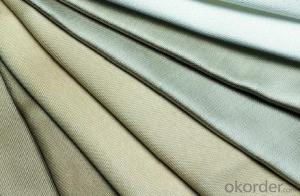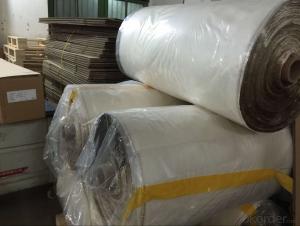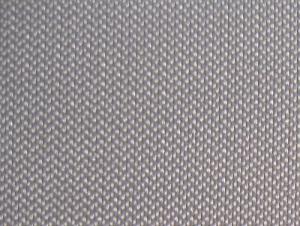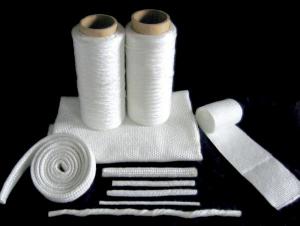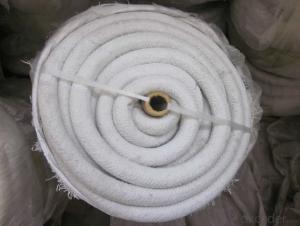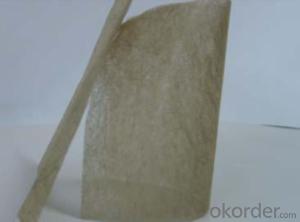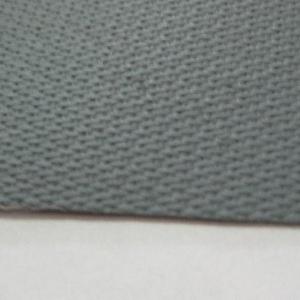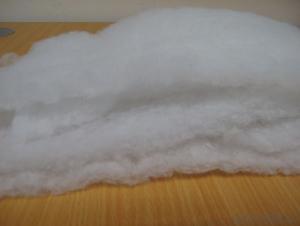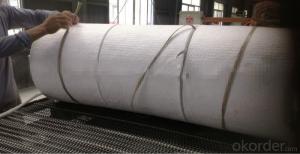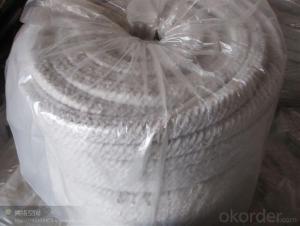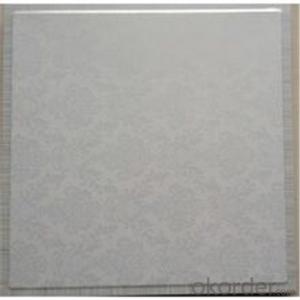36oz Silica Fiberglass Cloth Resisting 1000C for Heat Resistant
- Loading Port:
- China main port
- Payment Terms:
- TT OR LC
- Min Order Qty:
- 1000 m
- Supply Capability:
- 100000 m/month
OKorder Service Pledge
OKorder Financial Service
You Might Also Like
Product Description
Silica fiberglass is inorganic fiber that contents more than 96% of SiO2, it's resistant to high temperature, soft point 1700°C, long term service temperature 900 °C, it can work 10 minites at 1450 °C and keeps good state at 1600 °C for 15 seconds. For it's properties of chemical stability, high temperature resistance and ablation resistance, it widely used in aviationand aerospace, metallurgy, chemical, building material and fire fighting industry, etc.
Our factory is the only one that specialized manufacture silica fiberglass in China and has the production line of the whole process from marble making, fiber forming, weaving, and finish. The strength of silica fiberglass made from Na2O-B2O3-SiO2 system glass is 3-5 times higher than that from E glass. The products sold to more than 20 provinces, cities, autonomous regions and exported to foreign countries.
Silica fiberglass products are available in forms of needled mat, fabric, scrim, staple yarn, chopped strand and cord, etc.
Product Properties
1> SiO2>=96%
2> soft point nearly 1700°C, long-time working at 900°C
3> low thermal conductivity
4> good chemical stability
5> good electrical insulation
6> low thermal shrinkage
7> Non-asbestos product without pollution
8> good process performance
Product Uses
High temperature resistant, insulation and sealing material
High temperature ablation resistant material
Fireproof material (for fireproof protective clothe, fireproof curtain, fire blanket)
Dust collecting in media of high temperature gas and filtration in media of high temperature liquid
Filter for molten metal
Distinguisher, insulation material, filtration of automobile and motorcycle
Protective material for welding
Electricity insulation material
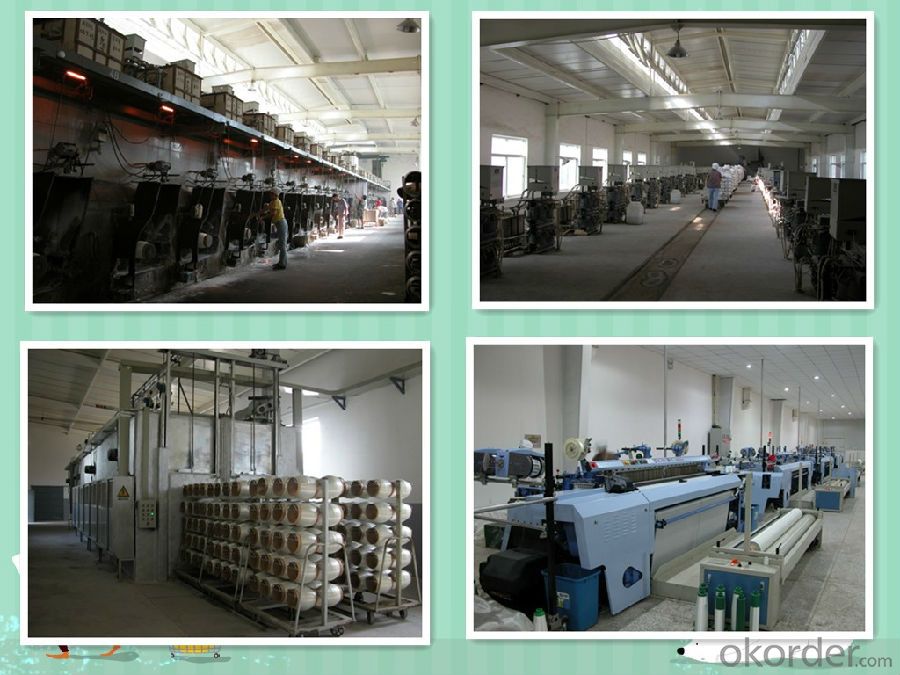

- Q:Can glass fiber textiles be cut with scissors?
- Yes, glass fiber textiles can be cut with scissors. Glass fiber textiles, also known as fiberglass fabrics, are made from fine strands of glass fibers woven together. While they are strong and durable, they can still be cut with scissors or other sharp cutting tools. However, it is important to note that the type and quality of scissors used may affect the ease and precision of the cut. It is recommended to use sharp and sturdy scissors specifically designed for cutting fabrics or fiberglass materials for the best results.
- Q:Can glass fiber textiles be folded or creased?
- Yes, glass fiber textiles can be folded or creased. Glass fiber textiles are flexible and can be manipulated into various shapes and forms. However, it is important to note that excessive folding or creasing may weaken the material and reduce its overall strength and durability. Therefore, it is recommended to handle glass fiber textiles with care and avoid sharp or tight creases to maintain their integrity.
- Q:How does glass fiber textile perform in low-temperature environments?
- Glass fiber textile performs well in low-temperature environments due to its inherent properties and characteristics. The material has a high resistance to cold temperatures and can maintain its structural integrity even in extreme cold conditions. Unlike other materials, glass fiber textile does not become brittle or lose its mechanical strength when exposed to low temperatures. The glass fibers used in the textile have a low coefficient of thermal expansion, which means they do not contract or expand significantly in response to temperature changes. This property allows the textile to remain stable and resistant to deformation or damage in low-temperature environments. Furthermore, glass fiber textile has excellent thermal insulation properties. It acts as a barrier to heat transfer, effectively preventing the loss of heat in cold environments. This insulation capability helps to maintain a comfortable temperature within a space, reducing the need for additional heating and energy consumption. In addition to being resistant to cold temperatures and providing thermal insulation, glass fiber textile is also highly durable. It is not affected by moisture or frost, which can be common in low-temperature environments. The textile remains unaffected by freezing and thawing cycles, ensuring its long-term performance and reliability. Overall, glass fiber textile is a reliable and effective material for use in low-temperature environments. Its resistance to cold temperatures, thermal insulation properties, and durability make it an ideal choice for various applications, including insulation in buildings, protective clothing, and aerospace components.
- Q:How do glass fiber textiles resist UV degradation?
- Glass fiber textiles possess inherent properties and undergo a manufacturing process that enables them to resist UV degradation. Molten glass is transformed into thin strands or filaments, which are subsequently woven or knitted together to create a textile. The molten glass utilized in this process incorporates various additives, including UV stabilizers. UV stabilizers, chemicals added to the glass fiber material, function to either absorb or reflect UV radiation. By serving as a barrier, these stabilizers effectively prevent the textile from deteriorating when subjected to sunlight or other sources of UV radiation. They obstruct the UV rays from reaching the fibers and causing harm. Furthermore, the physical structure of glass fibers contributes significantly to their ability to resist UV degradation. The smooth and non-porous surface of glass fibers hinders the penetration of UV rays, preventing them from breaking down the material. This structural integrity ensures the durability and strength of the textile even after prolonged exposure to UV radiation. Moreover, glass fibers possess a high melting point and display resistance to heat. This characteristic enables them to withstand high temperatures generated by UV radiation without experiencing degradation or melting. In conclusion, the combination of UV stabilizers, the physical structure of glass fibers, and their heat resistance renders glass fiber textiles exceptionally resistant to UV degradation. This resistance allows them to retain their integrity, strength, and appearance over time, making them suitable for outdoor applications where exposure to sunlight and UV radiation is prevalent.
- Q:Are glass fiber textiles resistant to wear and tear?
- Yes, glass fiber textiles are highly resistant to wear and tear. Due to their strong and durable nature, they can withstand repeated use and exposure to various environmental factors without losing their integrity or performance.
- Q:What are the different surface coating methods for glass fiber textile?
- Some common surface coating methods for glass fiber textiles include dip coating, spray coating, roll coating, and curtain coating. These methods involve applying a liquid coating material onto the surface of the glass fiber textile to enhance its properties such as resistance to water, chemicals, and abrasion.
- Q:I am producing 04 cloth of glass fiber. I want to know how to sell it
- China's production of glass fiber glass cloth, divided into two types of alkali and alkali, most of the foreign E-GLASS alkali free glass cloth.
- Q:What are the limitations of using glass fiber textile?
- There are several limitations associated with using glass fiber textiles. Firstly, glass fibers can be brittle and prone to breakage under certain conditions. This can limit their use in applications where flexibility and durability are required. Secondly, glass fibers have a relatively high thermal conductivity, meaning they are not as effective in providing insulation compared to other materials such as mineral wool or cellulose. This can limit their use in applications where thermal insulation is crucial. Additionally, glass fibers can be irritating to the skin and respiratory system when handled or inhaled. This can pose health risks for workers who come into contact with glass fiber textiles during manufacturing or installation processes. Moreover, glass fiber textiles are relatively expensive compared to other textile materials. This can limit their use in cost-sensitive applications where alternative materials may be more economical. Lastly, glass fiber textiles are susceptible to degradation when exposed to certain chemicals or environmental conditions. This can limit their use in corrosive or harsh environments, requiring additional protective coatings or treatments. Overall, while glass fiber textiles offer several advantages such as high strength, fire resistance, and dimensional stability, their limitations in terms of brittleness, thermal conductivity, health risks, cost, and susceptibility to degradation must be considered when selecting them for specific applications.
- Q:Can glass fiber textiles be used in the marine industry?
- Yes, glass fiber textiles can be used in the marine industry. They are commonly used in boat building and repair as they are lightweight, strong, and resistant to corrosion. Glass fiber textiles are often used to reinforce boat hulls, decks, and other structural components, providing strength and durability to withstand the harsh marine environment.
- Q:Can glass fiber textiles be used in the medical industry?
- Yes, glass fiber textiles can be used in the medical industry. Glass fiber textiles are made from fine strands of glass fibers which possess several desirable properties such as high strength, flexibility, and resistance to chemicals and heat. These properties make glass fiber textiles suitable for various applications in the medical industry. One major use of glass fiber textiles in the medical field is in the manufacturing of medical equipment and devices. For instance, glass fiber textiles can be used in the production of surgical gowns, masks, and other protective clothing for healthcare professionals. The high strength and durability of glass fiber textiles ensure that these protective garments provide effective barrier protection against pathogens and other contaminants. Glass fiber textiles can also be employed in wound care products. They can be used as reinforcement materials in bandages and dressings to provide additional strength and support to the wound area. The flexibility of glass fiber textiles allows for ease of movement and comfort for the patient while ensuring efficient wound healing. Moreover, glass fiber textiles can be utilized in the production of medical implants. The biocompatibility of these textiles ensures that they do not cause any adverse reactions or rejection when in contact with the human body. Glass fiber textiles can be incorporated into implantable devices such as bone screws, plates, and meshes, providing strength and stability to the implant structure. In addition, glass fiber textiles find applications in the field of tissue engineering, where they can be used as scaffolds for tissue regeneration. These textiles provide a three-dimensional structure to support the growth and development of new tissues. The porous nature of glass fiber textiles allows for the infiltration of cells, nutrients, and oxygen, facilitating tissue repair and regeneration. However, it is important to note that while glass fiber textiles offer several advantages in the medical industry, they may not be suitable for all applications. Some individuals may be allergic to glass fiber, and therefore, alternative materials should be considered in such cases. Additionally, proper sterilization techniques need to be employed to ensure the safety and effectiveness of glass fiber textiles in medical settings.
1. Manufacturer Overview |
|
|---|---|
| Location | |
| Year Established | |
| Annual Output Value | |
| Main Markets | |
| Company Certifications | |
2. Manufacturer Certificates |
|
|---|---|
| a) Certification Name | |
| Range | |
| Reference | |
| Validity Period | |
3. Manufacturer Capability |
|
|---|---|
| a)Trade Capacity | |
| Nearest Port | |
| Export Percentage | |
| No.of Employees in Trade Department | |
| Language Spoken: | |
| b)Factory Information | |
| Factory Size: | |
| No. of Production Lines | |
| Contract Manufacturing | |
| Product Price Range | |
Send your message to us
36oz Silica Fiberglass Cloth Resisting 1000C for Heat Resistant
- Loading Port:
- China main port
- Payment Terms:
- TT OR LC
- Min Order Qty:
- 1000 m
- Supply Capability:
- 100000 m/month
OKorder Service Pledge
OKorder Financial Service
Similar products
New products
Hot products
